Papers by Olga G Kashibadze
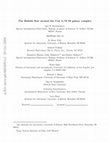
The Astronomical Journal, 2007
We present HST/ACS images and color-magnitude diagrams for 24 nearby galaxies in and near the con... more We present HST/ACS images and color-magnitude diagrams for 24 nearby galaxies in and near the constellation of Centaurus with radial velocities V LG < 550 km s −1 . Distances are determined based on the luminosities of stars at the tip of the red giant branch that range from 3.0 Mpc to 6.5 Mpc. The galaxies are concentrated in two spatially separated groups around Cen A (NGC 5128) and M 83 (NGC 5236). The Cen A group itself has a mean distance of 3.76±0.05 Mpc, a velocity dispersion of 136 kms −1 , a mean harmonic radius of 192 kpc, and an estimated orbital/virial mass of (6.4 − 8.1) · 10 12 M ⊙ . This elliptical dominated group is found to have a relatively high mass-to-light ratio: M/L B = 125 M ⊙ /L ⊙ . For the M 83 group we derived a mean distance of 4.79±0.10 Mpc, a velocity dispersion of 61 km s −1 , a mean harmonic radius of 89 kpc, and estimated orbital/virial mass of (0.8 − 0.9) · 10 12 M ⊙ . This spiral dominated group is found to have a relatively low M/L B = 34 M ⊙ /L ⊙ . The radius of the zero-velocity surface around Cen A lies at R 0 = 1.40 ± 0.11 Mpc. implying a total mass within R 0 of M T = (6.0 ± 1.4) · 10 12 M ⊙ . This value is in good agreement with the Cen A virial/orbital mass estimates and provides confirmation of the relatively high M/L B of this elliptical-dominated group. The centroids of both the groups, as well as surrounding field galaxies, have very small peculiar velocities, < 25 km s −1 , with respect to the local Hubble flow with H 0 = 68 km s −1 Mpc −1 .
Кашибадзе В.Ф., Насонова О.Г. Антропология донских казаков: опыт интеграции данных науки и литературы // Труды Южного научного центра РАН, том V: Социальные и гуманитарные науки. Ростов-на-Дону: Изд-во ЮНЦ РАН, 2009. С.167-177., 2009
Антропологическая история донских казаков подразумевает процессы миграции из юго-восточных зон Це... more Антропологическая история донских казаков подразумевает процессы миграции из юго-восточных зон Центральной России и незначительное включение южных и восточных элементов в возрастающей к югу пропорции. Совпадение антропологических данных начала и второй половины ХХ века указывает на преемственность физических характеристик этой группы населения и, отсюда, на выживание группы в процессе известных демографических коллизий. Статистический анализ антропологического портрета донских казаков в романе-энциклопедии М.А.Шолохова «Тихий Дон» показал соответствие портрета научным данным и воспроизведение в романе достоверной антропологической среды.
Кашибадзе В.Ф., Кашибадзе О.Г. Астрономический ландшафт в произведениях М.А.Шолохова. Вёшенский вестник, №6. Сборник материалов Международной научно-практической конференции «Шолоховские чтения-2006». — Ростов-на-Дону: Ростиздат, 2006.— С. 46-54., 2006

Monthly Notices of the Royal Astronomical Society, 2015
ABSTRACT We present new measurements of the abundance of galaxies with a given circular velocity ... more ABSTRACT We present new measurements of the abundance of galaxies with a given circular velocity in the Local Volume: a region centered on the Milky Way Galaxy and extending to distance 10Mpc. The sample of 750 mostly dwarf galaxies provides a unique opportunity to study the abundance and properties of galaxies down to absolute magnitudes MB= -10, and virial masses Mvir= 1e9Msun. We find that the standard LCDM model gives remarkably accurate estimates for the velocity function of galaxies with circular velocities V&gt;60kms and corresponding virial masses Mvir&gt; 3e10Msun, but it badly fails by over-predicting 5 times the abundance of large dwarfs with velocities V= 30-50kms. The Warm Dark Matter models cannot explain the data either, regardless of mass of the WDM particle. Just as in previous observational studies, we find a shallow asymptotic slope dN/dlog V = V**alpha, alpha =-1 of the velocity function, which is inconsistent with the standard LCDM model that predicts the slope alpha =-3. Though reminiscent to the known overabundance of satellites problem, the overabundance of field galaxies is a much more difficult problem. For the LCDM model to survive, in the 10Mpc radius of the Milky Way there should be 1000 dark galaxies with virial mass Mvir= 1e10Msun, extremely low surface brightness and no detectable HI gas. So far none of this type of galaxies have been discovered.

According to Sandage [1] and Lynden-Bell et al. [2], any sufficiently dense group or cluster of g... more According to Sandage [1] and Lynden-Bell et al. [2], any sufficiently dense group or cluster of galaxies may be characterized by a spherical "zero-velocity surface", which separates the group as overdensity against the homogenius cosmic expansion. The radius of this sphere is related to the total mass of the group, and this allows to estimate the masses of the nearby groups using the latest observational data on the galaxies of the Local Volume derived from the HST. The difference from other similar works [3,4] is that in this investigation the position of centroid is varied between the two most bright and therefore massive galaxies of the group, while in the earlier works on the subject it was fixed (usually one of the galaxies was considered as a centroid). The true location of the centroid can be determined confidently by a number of characteristics and agrees with other considerations. The results are compared with those obtained by other methods. Besides this, the non...

Bootes filament of galaxies is a dispersed chain of groups residing on sky between the Local Void... more Bootes filament of galaxies is a dispersed chain of groups residing on sky between the Local Void and the Virgo cluster. We consider a sample of 361 galaxies inside the sky area of $RA = 13.0^h ... 18.5^h$ and $Dec = -5^\circ ... +10^\circ$ with radial velocities $V_{LG} < 2000$ km/s to clarify its structure and kinematics. In this region, 161 galaxies have individual distance estimates. We use these data to draw the Hubble relation for galaxy groups, pairs as well as the field galaxies, and to examine the galaxy distribution on peculiar velocities. Our analysis exposes the known Virgo-centric infall at $RA < 14^h$ and some signs of outflow from the Local Void at $RA > 17^h$. According to the galaxy grouping criterion, this complex contains the members of 13 groups, 11 pairs and 140 field galaxies. The most prominent group is dominated by NGC5846. The Bootes filament contains the total stellar mass of $2.7\times10^{12} M_\odot$ and the total virial mass of $9.07\times10^{13...

Astrophysical Bulletin, 2015
ABSTRACT In the region of the sky limited by the coordinates RA = 7ḥ0-12ḥ0, Dec = 0°...+20° and e... more ABSTRACT In the region of the sky limited by the coordinates RA = 7ḥ0-12ḥ0, Dec = 0°...+20° and extending from the Virgo Cluster to the South Pole of the Local Supercluster, we consider the data on the galaxies with radial velocities V LG ≲ 2000 km/s. For 290 among them, we determine individual distances and peculiar velocities. In this region, known as the local velocity anomaly zone, there are 23 groups and 20 pairs of galaxies for which the estimates of virial/orbital masses are obtained. A nearby group around NGC3379 = Leo I and NGC3627 as well as the Local Group show the motion from the Local Void in the direction of Leo cloud with a characteristic velocity of about 400 km/s. Another rich group of galaxies around NGC3607 reveals peculiar velocity of about −420 km/s in the frame of reference related with the cosmic background radiation. A peculiar scattered association of dwarf galaxies Gemini Flock at a distance of 8 Mpc has the radial velocity dispersion of only 20 km/s and the size of approximately 0.7 Mpc. The virial mass estimate for it is 300 times greater than the total stellar mass. The ratio of the sum of virial masses of groups and pairs in the Leo/Can region to the sum of stellar masses of the galaxies contained in them equals 26, which is equivalent to the local average density Ω m (local) = 0.074, which is 3–4 times smaller than the global average density of matter.

Astrophysics, 2014
ABSTRACT We explore the structure and kinematics of a dispersed filament of galaxies residing bet... more ABSTRACT We explore the structure and kinematics of a dispersed filament of galaxies residing between the Local Void and the Virgo cluster. For such purpose, we consider a sample of 361 galaxies with radial velocities $V_{LG} &lt; 2000$ km/s inside the sky area of RA = [13.0 ... 18.0]$^h$ and Dec. = [$-$5 ... $+$10]$^\circ$. At present, 161 of them have individual distance estimates. The galaxy distribution on peculiar velocities along the strip exhibits the known Virgo-centric infall at RA &lt; 14$^h$ and some signs of outflow from the Local Void at RA &gt; 17$^h$. Majority of the Bootes strip galaxies (56%) belong to 13 groups and 11 pairs, with the most prominent group around NGC5846. The Bootes strip groups reside within [17$-$27]Mpc, being all farther from us than the Virgo cluster. The Bootes filament contains the total stellar mass of $2.7\times10^{12} M_\odot$ and the total virial mass of $9.07\times10^{13} M_\odot$, having the average density of dark matter to be \Omega_m = 0.09, i.e. a factor three lower than the global cosmic average.
Based on accurate measurements of distances to nearby galaxies made with Hubble Space Telescope, ... more Based on accurate measurements of distances to nearby galaxies made with Hubble Space Telescope, we determined the radii of the zero-velocity surface: R_0 = 0.96+-0.03 Mpc for the Local Group and R_0 = 0.89+-0.05 Mpc for the group of galaxies around M81/M82. This yields the total masses of the groups to be M_T = (1.29+-0.14) 10^{12} M_sun and M_T = (1.03+-0.17) 10^{12} M_sun, respectively. The R_0-method allowed us to determine the mass ratio of the brightest two members in the considered groups. Based on the minimum scatter of galaxies with respect to the Hubble regression, we derived a mass ratio of 0.8 : 1.0 for the Milky Way and Andromeda, and 0.54 : 1.00 for M82 and M81, which is quite close to the ratio of luminosities of these galaxies.
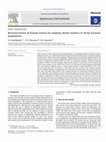
Kashibadze V.F., Nasonova O.G., Nasonov D.S. QI, 284, 3, 2013, Jan 23, 2013
Using advances in gene geography and anthropophenetics, the phenogeographical method for anthropo... more Using advances in gene geography and anthropophenetics, the phenogeographical method for anthropological research was initiated and developed using dental data. Statistical and cartographical analyses are provided for 498 living Eurasian populations. Mapping principal components supplied evidence for the phene pool structure in Eurasian populations, and for reconstructions of Homo sapiens history on the continent. Longitudinal variability seems to be the most important regularity revealed by principal components analysis (PCA) and mapping, indicating the division of the whole area into western and eastern main provinces. So, the most ancient scenario in the history of Eurasian populations developed from two perspective different groups: a western group related to ancient populations of West Asia and an eastern one rooted in ancestry in South and/or East Asia. In spite of the enormous territory and the revealed divergence, the populations of the continent have undergone wide scale and intensive time–space interaction. Many details in the revealed landscapes are background to different historical events. Migrations and assimilation are two essential phenomena in Eurasian history: the widespread of the western combination through the whole continent to the Pacific coastline and the movement of the paradoxical combinations of eastern and western markers from South or Central Asia to the east and west. Taking into account that no additional eastern combinations in the total variation in Asian groups have been found, but that mixed or western markers’ sets and that eastern dental characteristics are traced in Asia since Homo erectus, the assumption is made in favour of the hetero-level assimilation in the eastern province and of net-like evolution of H. sapiens.
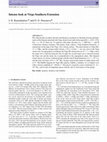
We collected data on radial velocities and distances of galaxies to elucidate structure and kinem... more We collected data on radial velocities and distances of galaxies to elucidate structure and kinematics of the filament attached to the Virgo cluster from south. In the region RA = [12. h 5-13. h 5], Dec. = [−20 • ,0 • ] there are 171 galaxies with radial velocities V LG < 2000 km s −1 , and 98 of them have distance estimates. This galaxy cloud, called as 'Virgo Southern Extension', is situated just on the edge of the Virgo 'zero-velocity surface'. The mean distance to Virgo SEx, 17 ± 2 Mpc, and the average radial velocity, 1172 ± 23 km s −1 , are very close to the Virgo cluster ones. In supergalactic coordinates the Virgo SEx dimensions are 15 × 7 × 2 Mpc, where the major axis is directed along the line of sight, the second major axis is directed towards the Virgo core and the minor one is perpendicular to the supergalactic plane. This flattened cloud consists of a dozen virialized groups with the total K-band luminosity of 1.7 × 10 12 L and the total virial mass of 6.3 × 10 13 M , having a typical dark matter-to-stellar matter ratio of 37. The Hubble diagram for Virgo SEx galaxies exhibits a tendency of a Z-shaped wave with a velocity amplitude of ∼250 km s −1 that may be caused by a mass overdensity of ∼6 × 10 13 M , and in order of magnitude agrees with the sum of virial masses of the groups.
A nearby friable cloud in Ursa Majoris contains 270 galaxies with radial velocities 500 < V LG < ... more A nearby friable cloud in Ursa Majoris contains 270 galaxies with radial velocities 500 < V LG < 1500 km s −1 inside the area of RA = [11 h . 0, 13 h . 0] and Dec. = [ + 40 • , +60 • ]. At present, 97 galaxies of them have individual distance estimates. We use these data to clarify the structure and kinematics of the UMa complex.
The Astrophysical …, Jan 1, 2011
We notice that nearby galaxies having high negative peculiar velocities are distributed over the ... more We notice that nearby galaxies having high negative peculiar velocities are distributed over the sky very inhomogeneously. A part of this anisotropy is caused by the "Local Velocity Anomaly", i.e. by the bulk motion of nearby galaxies away from the Local Void. But a half of the fast-flying objects reside within a small region [RA = 11.5 h − 13.0 h , Dec. = +20 • − +40 • ], known as the Coma I cloud. According to , this complex contains 8 groups, 5 triplets, 10 pairs and 83 single galaxies with the total mass of 4.7 · 10 13 M ⊙ .
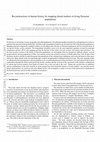
On the base of advantages in gene geography and anthropophenetics the phenogeographical method fo... more On the base of advantages in gene geography and anthropophenetics the phenogeographical method for anthropological research is initiated and experienced using dental data. Statistical and cartographical analyses are provided for 498 living Eurasian populations. Mapping principal components supplied evidence for the phene pool structure in Eurasian populations and for reconstructions of our species history on the continent. The longitudinal variability seems to be the most important regularity revealed by principal components analysis (PCA) and mapping proving the division of the whole area into western and eastern main provinces. So, the most ancient scenario in the history of Eurasian populations was developing from two perspective different groups: western group related to ancient populations of West Asia and the eastern one rooted by ancestry in South and/or East Asia. In spite of the enormous territory and the revealed divergence the populations of the continent have undergone wide scale and intensive time-space interaction. Many details in the revealed landscapes could be backgrounded to different historical events. The most amazing results are obtained for proving migrations and assimilation as two essential phenomena in Eurasian history: the wide spread of the western combination through the whole continent till the Pacific coastline and the envision of the movement of the paradox combinations of eastern and western markers from South or Central Asia to the east and to the west. Taking into account that no additional eastern combinations in the total variation in Asian groups have been found but mixed or western markers' sets and that eastern dental characteristics are traced in Asia since Homo erectus, the assumption is made in favour of the hetero-level assimilation in the Eastern province and of net-like evolution of our species.
We collected the existing data on the distances and radial velocities of galaxies around the Loca... more We collected the existing data on the distances and radial velocities of galaxies around the Local Void in the Aquila/Hercules to examine the peculiar velocity field induced by its underdensity. A sample of 1056 galaxies with distances measured from the Tip of the Red Giant Branch, the Cepheid luminosity, the SNIa luminosity, the surface brightness fluctuation method, and the Tully-Fisher relation has been used for this purpose. The amplitude of outflow is found to be ~300 km/s. The galaxies located within the void produce the mean intra-void number density about 1/5 of the mean external number density of galaxies. The void's population has a lower luminosity and a later morphological type with the medians: M_B = -15.7^m and T = 8 (Sdm), respectively.
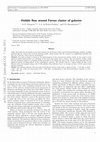
Astronomy & …, Jan 1, 2011
Aims. This work aims to provide a new mass estimate for the Fornax cluster and the Fornax-Eridanu... more Aims. This work aims to provide a new mass estimate for the Fornax cluster and the Fornax-Eridanus complex, avoiding methods like the virial or fits of X-ray emission profile, which assume that the system is in equilibrium, probably not the case of Fornax, still in process of formation. Methods. Our mass estimate is based on the determination of the zero-velocity surface which, in the context of the spherical infall model permits an evaluation of the total mass inside such a surface. The zero-velocity surface radius R0 was estimated either by a running median procedure or by fitting the data to the velocity field expected from the spherical model, including effects of the cosmological constant. The velocity field in a region within 20 Mpc of the Fornax center was mapped using a list of 109 galaxies whose distances have an average accuracy of 0.31 mag in their distance modulus.
Context. The standard ΛCDM cosmological model implies that all celestial bodies are embedded in a... more Context. The standard ΛCDM cosmological model implies that all celestial bodies are embedded in a perfectly uniform dark energy background, represented by Einstein's cosmological constant, and experience its repulsive antigravity action. Aims. Can dark energy have strong dynamical effects on small cosmic scales as well as globally? Continuing our efforts to clarify this question, we now focus on the Virgo Cluster and the flow of expansion around it. Methods. We interpret the Hubble diagram from a new database of velocities and distances of galaxies in the cluster and its environment, using a nonlinear analytical model, which incorporates the antigravity force in terms of Newtonian mechanics. The key parameter is the zero-gravity radius, the distance at which gravity and antigravity are in balance.
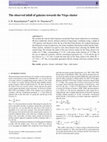
We examine the velocity field of galaxies around the Virgo cluster induced by its overdensity. We... more We examine the velocity field of galaxies around the Virgo cluster induced by its overdensity. We have studied the velocity-distance relation in Virgocentric coordinates using a sample of 1792 galaxies with distances from the tip of the Red Giant Branch, the Cepheid luminosity, the luminosity of type Ia supernovae, the surface brightness fluctuation method and the Tully-Fisher relation. Attention was paid to some observational biases affecting the Hubble flow around Virgo. We estimate the radius of the zero-velocity surface for the Virgo cluster to be within 5.0-7.5 Mpc, corresponding to 17-26 • at the mean cluster distance of 17.0 Mpc. In the case of spherical symmetry with the cosmological parameter m = 0.24 and the age of the Universe T 0 = 13.7 Gyr, it yields the total mass of the Virgo cluster to be within M T = (2.7-8.9) × 10 14 M in reasonable agreement with the existing virial mass estimates for the cluster.
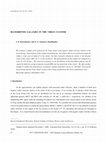
We examine a sample of 65 galaxies in the Virgo cluster with negative radial velocities relative ... more We examine a sample of 65 galaxies in the Virgo cluster with negative radial velocities relative to the Local Group. Some features of this sample are pointed out. All of these objects are positioned compactly within a virial zone of radius 6º in the cluster, but their centroid is displaced relative to the dynamic center of the cluster, M87, by 1º.1 to the northwest. The dwarf galaxies in this sample are clumped on a scale of ~10' (50 kpc). The observed asymmetry in the distribution of the blueshifted galaxies may be caused by infall of a group of galaxies around M86 onto the main body of the cluster. We offer another attempt to explain this phenomenon, assuming a mutual tangential velocity of ~300 km/s -1 between the Local Group and the Virgo cluster owing to their being repelled from the local cosmological void. exist in the group nearest us around the giant galaxies Maffei 1, Maffei 2, and IC342, but it is very difficult to measure radial velocities in this region of the sky because of the strong (~5 m -6 m ) absorption and emission by hydrogen in the Galaxy. It is evident that the observed distribution over the sky of galaxies with negative radial velocities reflects
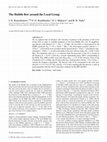
We use updated data on distances and velocities of galaxies in the proximity of the Local Group (... more We use updated data on distances and velocities of galaxies in the proximity of the Local Group (LG) in order to establish properties of the local Hubble flow. For 30 neighbouring galaxies with distances 0.7 < D LG < 3.0 Mpc, the local flow is characterized by the Hubble parameter H loc = (78 ± 2) km s −1 Mpc −1 , the mean-square peculiar velocity σ v = 25 km s −1 , corrected for errors of radial velocity measurements (∼4 km s −1 ) and distance measurements (∼10 km s −1 ), as well as the radius of the zero-velocity surface R 0 = (0.96 ± 0.03) Mpc. The minimum value for σ v is achieved when the barycentre of the LG is located at the distance D c = (0.55 ± 0.05) D M31 towards Andromeda galaxy (M31) corresponding to the Milky Way (MW)-to-M31 mass ratio M MW /M M31 4/5. In the reference frame of the 30 galaxies at 0.7-3.0 Mpc, the LG barycentre has a small peculiar velocity ∼(24 ± 4) km s −1 towards the Sculptor constellation. The derived value of R 0 corresponds to the total mass M T (LG) = (1.9 ± 0.2) 10 12 M with m = 0.24 and a topologically flat universe, a value in good agreement with the sum of virial mass estimates for the MW and M31.
Uploads
Papers by Olga G Kashibadze